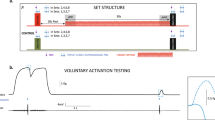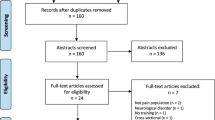Abstract
Rationale
When paired with training, substances that increase monoaminergic transmission in the brain support motor and language learning in healthy subjects and in rehabilitation after brain lesions.
Objectives
To test the hypotheses that enhancement of central norepinephrine by the selective norepinephrine reuptake inhibitor reboxetine (1) improves skilled motor performance, (2) promotes skilled motor learning, and (3) does not exert these effects by modulation of attention.
Methods
In a double blind, placebo-controlled, crossover study in healthy, adult subjects (n=16), finger-sequence performance and learning was measured after the stimulation of the central noradrenergic system with a single dose (8 mg) of reboxetine and placebo. Effects on attention were assessed by the standardized continuous performance test “CPT-M”.
Results
No differential effects of reboxetine or placebo on finger-sequence performance, learning and parameters of attention were found.
Conclusion
Selective stimulation of the central noradrenergic system did not promote skilled motor learning or performance as assessed by finger-sequences. The plasticity-enhancing effect of reboxetine, documented in other studies, appears to be dependent on specific neurophysiological and neuropsychological characteristics of the task, and cannot be generalized to other behavioral paradigms.

Similar content being viewed by others
References
Bourin M, Chue P, Guillon Y (2001) Paroxetine: a review. CNS Drug Rev 7:25–47
Boyeson MG, Feeney DM (1990) Intraventricular norepinephrine facilitates motor recovery following sensorimotor cortex injury. Pharmacol Biochem Behav 35:497–501
Boyeson MG, Harmon RL, Jones JL (1994) Comparative effects of fluoxetine, amitriptyline and serotonin on functional motor recovery after sensorimotor cortex injury. Am J Phys Med Rehabil 73:76–83
Breitenstein C, Wailke S, Bushuven S, Kamping S, Zwitserlood P, Ringelstein EB, Knecht S (2004) d-amphetamine boosts language learning independent of its cardiovascular and motor arousing effects. Neuropsychopharmacology 29:1704–1714
Butefisch CM, Davis BC, Wise SP, Sawaki L, Kopylev L, Classen J, Cohen LG (2000) Mechanisms of use-dependent plasticity in the human motor cortex. Proc Natl Acad Sci USA 97:3661–3665
Butefisch CM, Davis BC, Sawaki L, Waldvogel D, Classen J, Kopylev L, Cohen LG (2002) Modulation of use-dependent plasticity by d-amphetamine. Ann Neurol 51:59–68
Butovas S, Lukkarinen J, Virtanen T, Jolkkonen J, Sivenius J (2001) Differential effect of the alpha2-adrenoceptor antagonist, atipamezole, in limb-placing task and skilled forepaw use following experimental stroke. Restor Neurol Neurosci 18:143–151
Castro-Alamancos MA, Donoghue JP, Connors BW (1995) Different forms of synaptic plasticity in somatosensory and motor areas of the neocortex. J Neurosci 15:5324–5333
Chen R, Cohen LG, Hallett M (2002) Nervous system reorganization following injury. Neuroscience 111:761–773
Cirstea CM, Ptito A, Levin MF (2006) Feedback and cognition in arm motor skill reacquisition after stroke. Stroke (Apr 6, in press)
Classen J, Liepert J, Wise SP, Hallett M, Cohen LG (1998) Rapid plasticity of human cortical movement representation induced by practice. J Neurophysiol 79:1117–1123
Feeney DM, Sutton RL (1987) Pharmacotherapy for recovery of function after brain injury. Crit Rev Neurobiol 3:135–197
Goldstein LB, Davis JN (1990) Clonidine impairs recovery of beam-walking after a sensorimotor cortex lesion in the rat. Brain Res 508:305–309
Green DM, Swets JA (1966) Signal detection theory and psychophysics. Wiley, New York
Harmer CJ, Hill SA, Taylor MJ, Cowen PJ, Goodwin GM (2003) Toward a neuropsychological theory of antidepressant drug action: increase in positive emotional bias after potentiation of norepinephrine activity. Am J Psychiatry 160:990–992
Harmer CJ, Shelley NC, Cowen PJ, Goodwin GM (2004) Increased positive versus negative affective perception and memory in healthy volunteers following selective serotonin and norepinephrine reuptake inhibition. Am J Psychiatry 161:1256–1263
Hegerl U, Mergl R, Henkel V, Pogarell O, Müller-Siecheneder F, Frodl T, Juckel G (2005) Differential effects of reboxetine and citalopram on hand-motor function in patients suffering from major depression. Psychopharmacology (Berl) 178:58–66
Herrmann WM, Fuder H (1998) Reboxetine, a selective noradrenaline reuptake inhibitor, is non-sedative and does not impair psychomotor performance in healthy subjects. Hum Psychopharmacol 13:425–433
Herwig U, Brauer K, Connemann B, Spitzer M, Schonfeldt-Lecuona C (2002) Intracortical excitability is modulated by a norepinephrine-reuptake inhibitor as measured with paired-pulse transcranial magnetic stimulation. Psychopharmacology (Berl) 164:228–232
Hummel F, Andres F, Altenmüller E et al (2002) Inhibitory control of acquired motor programmes in the human brain. Brain 125:404–420
Hurlemann R, Hawellek B, Matusch A et al (2005) Noradrenergic modulation of emotion-induced forgetting and remembering. J Neurosci 25:6343–6349
Izumi Y, Zorumski CF (1999) Norepinephrine promotes long-term potentiation in the adult rat hippocampus in vitro. Synapse 31:196–202
Jacobs KM, Donoghue JP (1991) Reshaping the cortical motor map by unmasking latent intracortical connections. Science 251:944–947
Kathmann N, Wagner M, Satzger W, Engel RR (1996) Vigilanzmessung auf Verhaltensebene: Der Continuous Performance Test—München (CPT-M). In: Möller HJ, Engel RR, Hoff P (eds) Befunderhebung in der Psychiatrie. Springer, Berlin Heidelberg New York, pp 238–331
Kerr JS, Powell J, Hindmarch I (1996) The effects of reboxetine and amitriptyline, with and without alcohol on cognitive function and psychomotor performance. Br J Clin Pharmacol 42:239–241
Kikuchi K, Nishino K, Ohyu H (2000) l-DOPS-Accelerated recovery of locomotor function in rats subjected to sensorimotor cortex ablation injury: pharmacobehavioral studies. Tohoku J Exp Med 188:203–215
Loubinoux I, Pariente J, Rascol O, Celsis P, Chollet F (2002) Selective serotonin reuptake inhibitor paroxetine modulates motor behavior through practice. A double-blind, placebo-controlled, multi-dose study in healthy subjects. Neuropsychologia 40:1815–1821
Nishino K, Sasaki T, Takahashi K, Chiba M, Ito T (2001) The norepinephrine precursor l-threo-3, 4-dihydroxyphenylserine facilitates motor recovery in chronic stroke patients. J Clin Neurosci 8:547–550
Nudo RJ, Plautz EJ, Frost SB (2001) Role of adaptive plasticity in recovery of function after damage to motor cortex. Muscle Nerve 24:1000–1019
O’Carroll RE, Drysdale E, Cahill L, Shajahan P, Ebmeier KP (1999) Stimulation of the noradrenergic system enhances and blockade reduces memory for emotional material in man. Psychol Med 29:1083–1088
Oldfield RC (1971) The assessment and analysis of handedness: the Edinburgh inventory. Neuropsychologia 9:97–113
Pascual-Leone A, Nguyet D, Cohen,LG, Brasil-Neto JP, Cammarota A, Hallett M (1995) Modulation of muscle responses evoked by transcranial magnetic stimulation during the acquisition of new fine motor skills. J Neurophysiol 74:1037–1045
Plewnia C, Bartels M, Cohen L, Gerloff C (2001) Noradrenergic modulation of human cortex excitability by the presynaptic alpha(2)-antagonist yohimbine. Neurosci Lett 30:41–44
Plewnia C, Hoppe J, Hiemke C, Bartels M, Gerloff C (2002) Enhancement of human cortico-motoneuronal excitability by the selective norepinephrine re-uptake inhibitor reboxetine. Neurosci Lett 330:231–234
Plewnia C, Hoppe J, Cohen LG, Gerloff C (2004) Improved motor skill acquisition after selective stimulation of central norepinephrine. Neurology 62:2124–2126
Sawaki L, Cohen LG, Classen J, Davis BC, Bütefisch CM (2002) Enhancement of use-dependent plasticity by d-amphetamine. Neurology 59:1262–1264
Scheidtmann K (2004) Advances in adjuvant pharmacotherapy for motor rehabilitation: effects of levodopa. Restor Neurol Neurosci 22:393–398
Scheidtmann K, Fries W, Müller F, Koenig E (2001) Effects of levodopa in combination with physiotherapy on functional motor recovery after stroke: a prospective, randomised, double-blind study. Lancet 358:787–790
Schmanke TD, Avery RA, Barth TM (1996) The effects of amphetamine on recovery of function after cortical damage in the rat depend on the behavioral requirements of the task. J Neurotrauma 13:293–307
Stibick DL, Feeney DM (2001) Enduring vulnerability to transient reinstatement of hemiplegia by prazosin after traumatic brain injury. J Neurotrauma 18:303–312
Stroemer RP, Kent TA, Hulsebosch CE (1998) Enhanced neocortical neural sprouting, synaptogenesis, and behavioral recovery with d-amphetamine therapy after neocortical infarction in rats. Stroke 29:2381–2393
Sutton RL, Feeney DM (1992) α-noradrenergic agonists an d antagonists affect recovery and maintenance of beam walking ability after sensorimotor cortex ablation in rat. Restor Neurol Neurosci 4:1–11
Walter CB (1992) Potentiating ballistic limb movements through voluntary production of the stretch-shorten cycle. Percept Mot Skills 74:435–442
Walker-Batson D, Smith P, Curtis S et al (1995) Amphetamine paired with physical therapy accelerates motor recovery after stroke. Further evidence. Stroke 26:2254–2259
Walker-Batson D, Curtis S, Natarajan R et al (2001) A double-blind, placebo-controlled study of the use of amphetamine in the treatment of aphasia. Stroke. 32:2093–2098
Wong EH, Sonders MS, Amara SG et al (2000) Reboxetine: a pharmacologically potent, selective, and specific norepinephrine reuptake inhibitor. Biol Psychiatry 47:818–829
Ziemann U, Muellbacher W, Hallett M, Cohen LG (2001) Modulation of practice-dependent plasticity in human motor cortex. Brain 124:1171–1181
Acknowledgements
This work was supported by the German Research Council Collaborative Research Center 550, project C5.
Author information
Authors and Affiliations
Corresponding author
Rights and permissions
About this article
Cite this article
Plewnia, C., Hoppe, J. & Gerloff, C. No effects of enhanced central norepinephrine on finger-sequence learning and attention. Psychopharmacology 187, 260–265 (2006). https://doi.org/10.1007/s00213-006-0420-5
Received:
Accepted:
Published:
Issue Date:
DOI: https://doi.org/10.1007/s00213-006-0420-5




